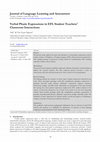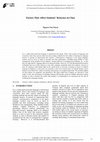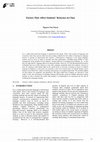Conference Presentations by Nguyen Van Tuyen

Purpose:
The present study explores the types and utilization of verbal phatic expressions used... more Purpose:
The present study explores the types and utilization of verbal phatic expressions used by student teachers of English as a Foreign Language (EFL) during classroom interactions. This teaching strategy is perceived as being crucial for communicative EFL teaching especially in high-context cultures.
Methodology:
The present study adopted a qualitative approach utilizing a descriptive research design to address the research inquiries. The data collection process involved a series of observations and semi-structured interviews, with a cohort of seven participants.
Results/Findings:
The findings indicate the existence of twelve types of phatic expressions observed in the study. These encompass greetings, small talk, compliments, apologies, expressions of gratitude, farewells, polite phrases, affirmative expressions, negative responses, interjections, hedges, and filler words. Meanwhile, an examination of the data revealed that among the various phatic expressions employed by EFL student teachers in the context of classroom interaction, ten of them were found to be the most frequently utilized. These include greetings, small talk, compliments, apologies, expressions of gratitude, farewells, polite phrases, affirmative expressions, hedges, and filler words. The utilization of these expressions by student teachers served the purpose of facilitating a seamless continuity of interaction within the classroom.
Implications:
This qualitative study presents pedagogical implications that are relevant to both EFL teachers and students, as it highlights the significance of exposure to both language competence and performance in the educational setting.

English language testing and assessment for school-age learners
With the launch of the National Foreign Language 2020 Project, the Vietnamese Ministry ofEducatio... more With the launch of the National Foreign Language 2020 Project, the Vietnamese Ministry ofEducation and Training (MOET) has implemented a new English curriculumfor all educational levelsfrom primary to high school level, which aims to help students respectively achieve level 1, 2 and 3 in the national languageframework (that is Al, A2, and B1 in CEFR) when theyfinish primary, lower and upper secondary school. Together with the introduction of the new curriculum, newforeign language assessment policy has also been implemented to facilitate the language teaching and learning quality within the national education system. Further, better-researched guidance and more training on language assessment have been providedfor English language teachers. New English test items and test banks have been developed in order to facilitate the task of undertakingformative and summative assessment. It has been expected that there is a smooth shiftfrom the traditional summative assessment which is very ofien associated with the use of tests to using information and feedback from formative assessment to improve teaching and learning process. That is assessmentfor learning and assessment as learning.
Papers by Nguyen Van Tuyen

Proceedings of the International Conference on Education in Muslim Society (ICEMS 2017), 2018
It is a widely held axiom that language is intertwined with culture. That is why teachers of lang... more It is a widely held axiom that language is intertwined with culture. That is why teachers of languages and researchers show their concern about not only teaching methods but also culture of learning by language learners. In pursuit of empowering their learners' communicative competence in the target language, teachers need to invest as much as possible into their performance, including being flexible in class management, being mindful of their students' cultural behaviors or pedagogical psychology, etc., so that they can help learners' language skills to be enhanced further. However, it is well-documented that teachers of English and even of other subjects in Asia often complain continually about their students' reticence in class. In seeking to shed further light on the causal factors of reticence occurring in classes of students majoring in English at a University, the researcher of this mini research bases on cultural identity, power distance, and collectivists' culture of teaching and learning as conceptual frameworks. The methods applied for data analysis are qualitative and quantitative. The paper found that if students are reluctant to work orally in class, the real purpose of language teaching and learning cannot be fulfilled. Interaction among students as well as between the teacher and students is recommended to be maximized for the sake of communicative language learning.
XLinguae, 2023
The present study aims to examine the effects of incorporating online systematic guided reading s... more The present study aims to examine the effects of incorporating online systematic guided reading strategies (SGRS) on the reading performance of English as a foreign language (EFL) learners. The study employed a mixed-method approach with a onegroup pre-test and post-test design. The participants were recruited from second-year students majoring in English language. The quantitative data were subjected to statistical analysis using a t-test, while the qualitative data were analyzed and interpreted based on the participants' responses to open-ended survey questions and in-depth interviews regarding the use of online SGRS. The findings indicate that the implementation of SGRS significantly improved the reading performance of EFL students (p < 0.05). The study's implications for EFL teaching and research on learners' reading competence are also discussed in depth.

Alantis Press, 2017
It is a widely held axiom that language is intertwined with culture. That is why teachers of lang... more It is a widely held axiom that language is intertwined with culture. That is why teachers of languages and researchers show their concern about not only teaching methods but also culture of learning by language learners. In pursuit of empowering their learners' communicative competence in the target language, teachers need to invest as much as possible into their performance, including being flexible in class management, being mindful of their students' cultural behaviors or pedagogical psychology, etc., so that they can help learners' language skills to be enhanced further. However, it is well-documented that teachers of English and even of other subjects in Asia often complain continually about their students' reticence in class. In seeking to shed further light on the causal factors of reticence occurring in classes of students majoring in English at a University, the researcher of this mini research bases on cultural identity, power distance, and collectivists' culture of teaching and learning as conceptual frameworks. The methods applied for data analysis are qualitative and quantitative. The paper found that if students are reluctant to work orally in class, the real purpose of language teaching and learning cannot be fulfilled. Interaction among students as well as between the teacher and students is recommended to be maximized for the sake of communicative language learning.








Uploads
Conference Presentations by Nguyen Van Tuyen
The present study explores the types and utilization of verbal phatic expressions used by student teachers of English as a Foreign Language (EFL) during classroom interactions. This teaching strategy is perceived as being crucial for communicative EFL teaching especially in high-context cultures.
Methodology:
The present study adopted a qualitative approach utilizing a descriptive research design to address the research inquiries. The data collection process involved a series of observations and semi-structured interviews, with a cohort of seven participants.
Results/Findings:
The findings indicate the existence of twelve types of phatic expressions observed in the study. These encompass greetings, small talk, compliments, apologies, expressions of gratitude, farewells, polite phrases, affirmative expressions, negative responses, interjections, hedges, and filler words. Meanwhile, an examination of the data revealed that among the various phatic expressions employed by EFL student teachers in the context of classroom interaction, ten of them were found to be the most frequently utilized. These include greetings, small talk, compliments, apologies, expressions of gratitude, farewells, polite phrases, affirmative expressions, hedges, and filler words. The utilization of these expressions by student teachers served the purpose of facilitating a seamless continuity of interaction within the classroom.
Implications:
This qualitative study presents pedagogical implications that are relevant to both EFL teachers and students, as it highlights the significance of exposure to both language competence and performance in the educational setting.
Papers by Nguyen Van Tuyen
The present study explores the types and utilization of verbal phatic expressions used by student teachers of English as a Foreign Language (EFL) during classroom interactions. This teaching strategy is perceived as being crucial for communicative EFL teaching especially in high-context cultures.
Methodology:
The present study adopted a qualitative approach utilizing a descriptive research design to address the research inquiries. The data collection process involved a series of observations and semi-structured interviews, with a cohort of seven participants.
Results/Findings:
The findings indicate the existence of twelve types of phatic expressions observed in the study. These encompass greetings, small talk, compliments, apologies, expressions of gratitude, farewells, polite phrases, affirmative expressions, negative responses, interjections, hedges, and filler words. Meanwhile, an examination of the data revealed that among the various phatic expressions employed by EFL student teachers in the context of classroom interaction, ten of them were found to be the most frequently utilized. These include greetings, small talk, compliments, apologies, expressions of gratitude, farewells, polite phrases, affirmative expressions, hedges, and filler words. The utilization of these expressions by student teachers served the purpose of facilitating a seamless continuity of interaction within the classroom.
Implications:
This qualitative study presents pedagogical implications that are relevant to both EFL teachers and students, as it highlights the significance of exposure to both language competence and performance in the educational setting.